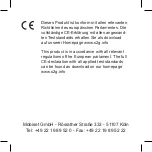
CEBORA S.p.A.
7
The 540 Vdc voltage present at the output of the rectifier bridge is applied to the flyback
board (539), which acts as a main power source and generates the service voltages for the
various system circuits (power source, wire feeder, control panel).
The inverter is made up of four igbt (2 for each igbt module (548)) connected in an “H-
bridge” configuration, driven by the driver-igbt boards (548) mounted directly on the terminals
of the igbt modules (548), in turn controlled by the interface board (543).
Mounted on the power terminals of the igbt modules (548) are two “snubber” capacitors,
electrically connected in parallel to the DC-capacitors (561), whose task is to reduce the
overvoltages that develop on the igbt during operation. Their integrity and connection (which
must be as short as possible on the igbt terminals) is essential for the inverter to operate;
tampering with them may seriously damage the igbt (548).
The task of the igbt inverter is to generate the square-wave alternating voltage for the power
transformer (531). The welding current is adjusted by modulating this voltage appropriately.
The TA (558) inserted in the circuit between an igbt module (548) and the transformer (531)
provides the micro board (543) with the feed-back signal of the current at the primary circuit of
the transformer (531), to verify that the inverter is working properly; this signal does not
normally affect the welding current adjustment.
The transformer (531) provides the secondary circuit with voltage and current values suitable
for welding. Its secondary circuit is made up of 4 windings connected to a shared point on the
central socket, to which the choke (530) is connected to level the welding current.
The other ends of the windings are connected to the diode group (567), which rectifies the
alternating current generated by the inverter, making it available at the power source output.
The diode group (567) is made up of 4 diodes connected to a shared cathode, and provides a
positive output voltage compared to the central socket of the transformer (531). Actually, each
diode in the group is in turn made up of two diodes parallel connected together.
The Hall-effect current transducer (529), inserted at the diode group (567) output, sends the
feed-back signal of the secondary current to the micro board (543), to regulate the welding
current.
The output voltage signal of the power source, used by the interface board (543) to adapt the
behavior of the power source based on the conditions of the welding arc in the various possible
types of welding, is taken from the “+”(BR) and “–”(BO) output terminals of the power source.
The micro board (543) contains the main microprocessor of the power source (MASTER).
It supervises management of the other boards, more specialized in their respective functions,
regulates the welding current by generating the PWM signal to be sent to the driver-igbt boards
(548), and communicates with the microprocessors of the control panel (PANEL) and wire
feeder (MOTOR) (see par. 2.3).
The temperature signals from the thermostat board (551), located among the igbt modules
(548), to detect the temperature of the inverter, and from the thermostat (526) mounted on the
dissipater of the diode group (567), to detect its temperature, both lead to the interface board
(543).
The fan (512) to cool the power elements of the power source is controlled by the interface
board (543). Its operation is conditioned by the temperature of the inverter and diode group and
the ambient temperature, and in particular, is activated in the following conditions:
−
upon machine start-up, and for 10 seconds after the pre-charge phase;
−
with ambient temperature greater than 40°C;
−
during welding, in the 3 minutes after welding is finished, and after 3 minutes if the igbt
temperature (548) is greater than 40°C;
−
with the machine blocked, signaling an error code;
−
when the machine is shut off.
The connector (506) to connect the wire feeder is located on the rear panel of the power
source.
3.302.191
15/02/05








































